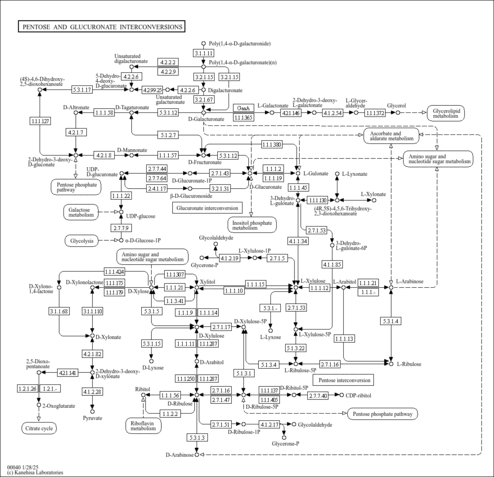| Identification |
|---|
| YMDB ID | YMDB00867 |
|---|
| Name | CDP-ribitol |
|---|
| Species | Saccharomyces cerevisiae |
|---|
| Strain | Baker's yeast |
|---|
| Description | CDP-ribitol, also known as CDP ribitol, belongs to the class of organic compounds known as pyrimidine ribonucleoside diphosphates. These are pyrimidine ribonucleotides with diphosphate group linked to the ribose moiety. CDP-ribitol is an extremely weak basic (essentially neutral) compound (based on its pKa). CDP-ribitol exists in both E. coli (prokaryote) and yeast (eukaryote). |
|---|
| Structure | |
|---|
| Synonyms | - CDP 5-ester with D-ribitol
- Cdp ribitol
- CDP-L-ribitol
- CDPribitol
- Cytidine 5'-(trihydrogen diphosphate), P'-5-ester with D-ribitol
- Cytidine diphosphate ribitol
- Cytidine 5'-(trihydrogen diphosphoric acid), p'-5-ester with D-ribitol
- Cytidine diphosphoric acid ribitol
|
|---|
| CAS number | 3506-17-0 |
|---|
| Weight | Average: 537.3069
Monoisotopic: 537.076090169 |
|---|
| InChI Key | DPJKHFICSGCNIR-HRENORGGSA-N |
|---|
| InChI | InChI=1S/C14H25N3O15P2/c15-9-1-2-17(14(24)16-9)13-12(23)11(22)8(31-13)5-30-34(27,28)32-33(25,26)29-4-7(20)10(21)6(19)3-18/h1-2,6-8,10-13,18-23H,3-5H2,(H,25,26)(H,27,28)(H2,15,16,24)/t6-,7+,8+,10-,11+,12+,13+/m0/s1 |
|---|
| IUPAC Name | {[(2R,3S,4R,5R)-5-(4-amino-2-oxo-1,2-dihydropyrimidin-1-yl)-3,4-dihydroxyoxolan-2-yl]methoxy}({[hydroxy({[(2R,3S,4S)-2,3,4,5-tetrahydroxypentyl]oxy})phosphoryl]oxy})phosphinic acid |
|---|
| Traditional IUPAC Name | cdp ribitol |
|---|
| Chemical Formula | C14H25N3O15P2 |
|---|
| SMILES | [H][C@](O)(CO)[C@]([H])(O)[C@]([H])(O)COP(O)(=O)OP(O)(=O)OC[C@H]1O[C@H]([C@H](O)[C@@H]1O)N1C=CC(N)=NC1=O |
|---|
| Chemical Taxonomy |
|---|
| Description | belongs to the class of organic compounds known as pyrimidine ribonucleoside diphosphates. These are pyrimidine ribonucleotides with diphosphate group linked to the ribose moiety. |
|---|
| Kingdom | Organic compounds |
|---|
| Super Class | Nucleosides, nucleotides, and analogues |
|---|
| Class | Pyrimidine nucleotides |
|---|
| Sub Class | Pyrimidine ribonucleotides |
|---|
| Direct Parent | Pyrimidine ribonucleoside diphosphates |
|---|
| Alternative Parents | |
|---|
| Substituents | - Pyrimidine ribonucleoside diphosphate
- Pentose-5-phosphate
- Pentose phosphate
- Glycosyl compound
- N-glycosyl compound
- Monosaccharide phosphate
- Organic pyrophosphate
- Aminopyrimidine
- Pyrimidone
- Monoalkyl phosphate
- Hydropyrimidine
- Alkyl phosphate
- Phosphoric acid ester
- Pyrimidine
- Imidolactam
- Monosaccharide
- Organic phosphoric acid derivative
- Tetrahydrofuran
- Heteroaromatic compound
- Secondary alcohol
- Oxacycle
- Azacycle
- Organoheterocyclic compound
- Polyol
- Organonitrogen compound
- Organic nitrogen compound
- Amine
- Alcohol
- Hydrocarbon derivative
- Organic oxide
- Organopnictogen compound
- Organic oxygen compound
- Organooxygen compound
- Primary amine
- Primary alcohol
- Aromatic heteromonocyclic compound
|
|---|
| Molecular Framework | Aromatic heteromonocyclic compounds |
|---|
| External Descriptors | |
|---|
| Physical Properties |
|---|
| State | Not Available |
|---|
| Charge | 0 |
|---|
| Melting point | Not Available |
|---|
| Experimental Properties | | Property | Value | Reference |
|---|
| Water Solubility | Not Available | PhysProp | | LogP | Not Available | PhysProp |
|
|---|
| Predicted Properties | |
|---|
| Biological Properties |
|---|
| Cellular Locations | Not Available |
|---|
| Organoleptic Properties | Not Available |
|---|
| SMPDB Pathways | Not Available |
|---|
| KEGG Pathways | | Pentose and glucuronate interconversions | ec00040 |  |
|
|---|
| SMPDB Reactions | Not Available |
|---|
| KEGG Reactions | Not Available |
|---|
| Concentrations |
|---|
| Intracellular Concentrations | Not Available |
|---|
| Extracellular Concentrations | Not Available |
|---|
| Spectra |
|---|
| Spectra | | Spectrum Type | Description | Splash Key | View |
|---|
| Predicted LC-MS/MS | Predicted LC-MS/MS Spectrum - 10V, Positive | splash10-03di-0900010000-6e1fcdeba40ba224ed0b | JSpectraViewer | | Predicted LC-MS/MS | Predicted LC-MS/MS Spectrum - 20V, Positive | splash10-03di-3910000000-ae705be2942ba94101e1 | JSpectraViewer | | Predicted LC-MS/MS | Predicted LC-MS/MS Spectrum - 40V, Positive | splash10-03di-6910000000-f3aaafb52fa945f1a801 | JSpectraViewer | | Predicted LC-MS/MS | Predicted LC-MS/MS Spectrum - 10V, Negative | splash10-01w0-9401840000-00c2c44a62fdbcf52c04 | JSpectraViewer | | Predicted LC-MS/MS | Predicted LC-MS/MS Spectrum - 20V, Negative | splash10-08fr-9533100000-b72dd29a8a03e4ce91e3 | JSpectraViewer | | Predicted LC-MS/MS | Predicted LC-MS/MS Spectrum - 40V, Negative | splash10-0bvl-6910000000-04014d88bb0d69f9f1c7 | JSpectraViewer |
|
|---|
| References |
|---|
| References: | - Scheer, M., Grote, A., Chang, A., Schomburg, I., Munaretto, C., Rother, M., Sohngen, C., Stelzer, M., Thiele, J., Schomburg, D. (2011). "BRENDA, the enzyme information system in 2011." Nucleic Acids Res 39:D670-D676.21062828
- SHAW, D. R. (1962). "Pyrophosphorolysis and enzymic synthesis of cytidine diphosphate glycerol and cytidine diphosphate ribitol." Biochem J 82:297-312.13911452
|
|---|
| Synthesis Reference: | Not Available |
|---|
| External Links: | | Resource | Link |
|---|
| CHEBI ID | 16022 | | HMDB ID | Not Available | | Pubchem Compound ID | 46878411 | | Kegg ID | C00789 | | ChemSpider ID | Not Available | | FOODB ID | Not Available | | Wikipedia ID | Not Available | | BioCyc ID | Not Available |
|
|---|

